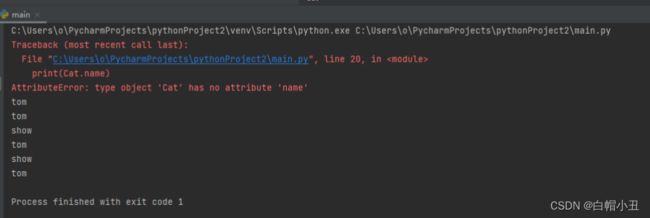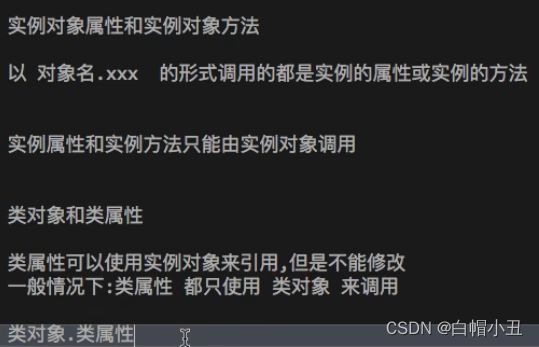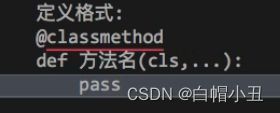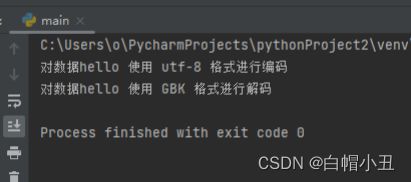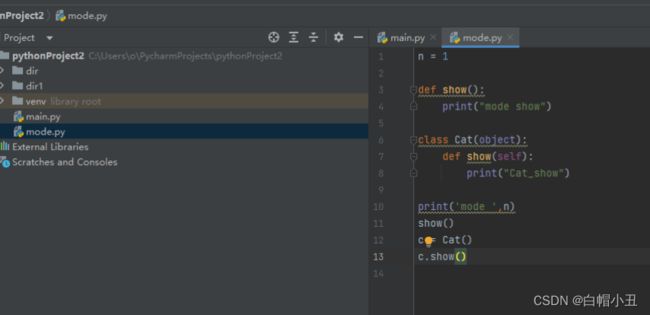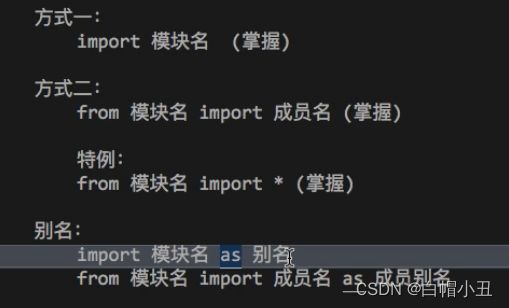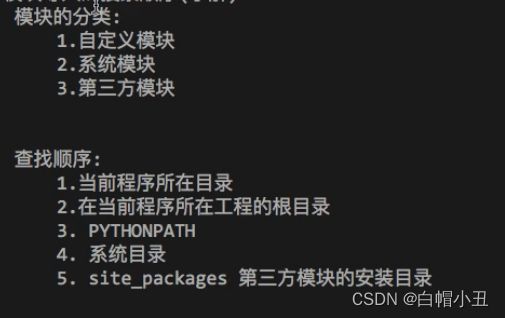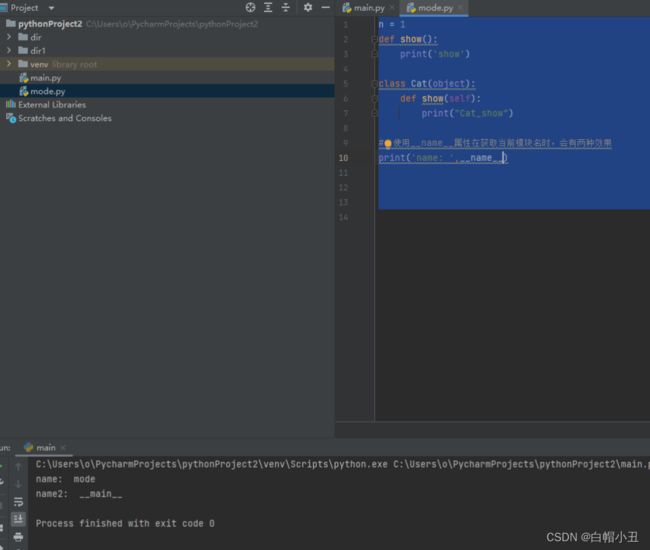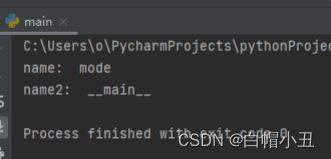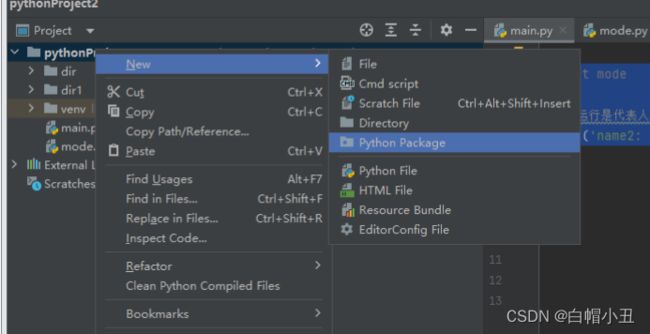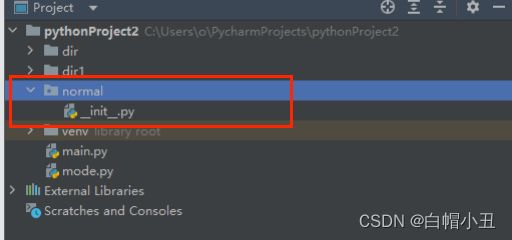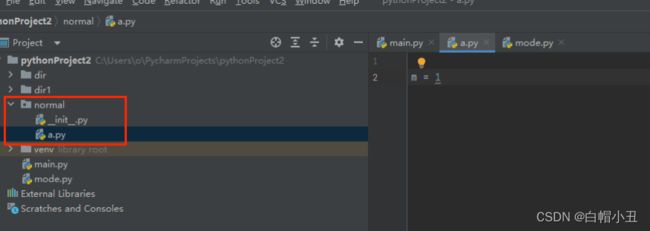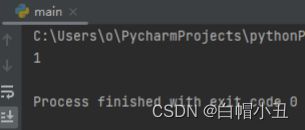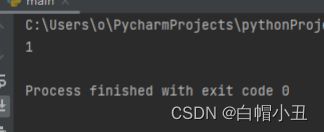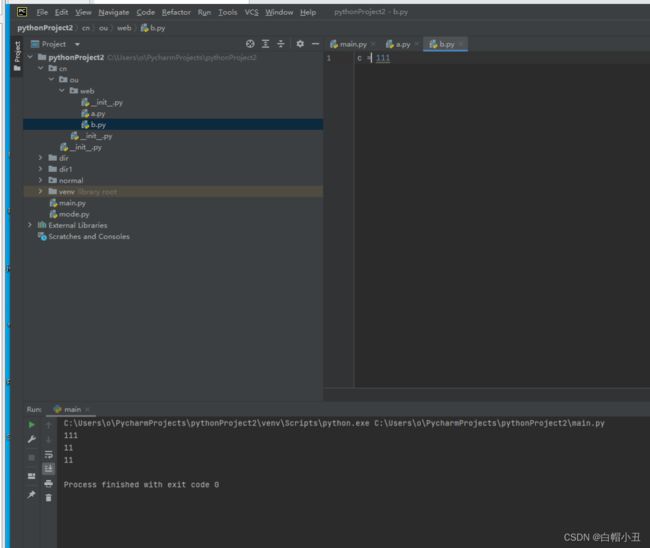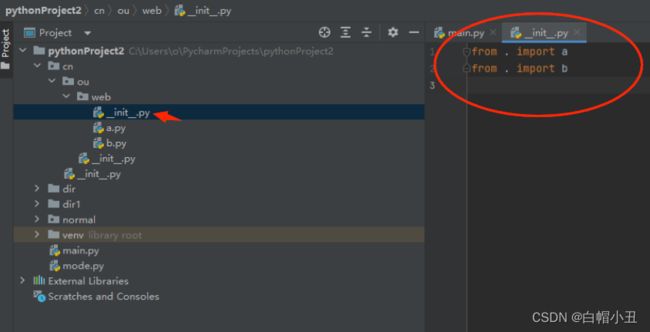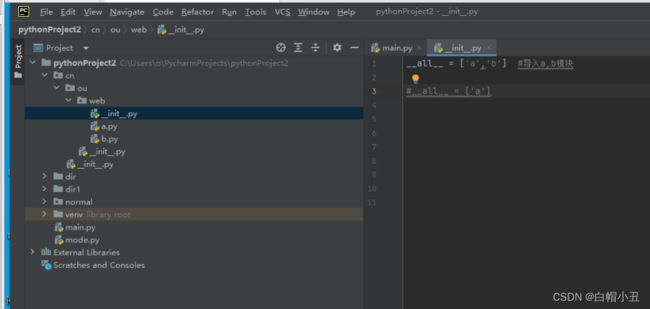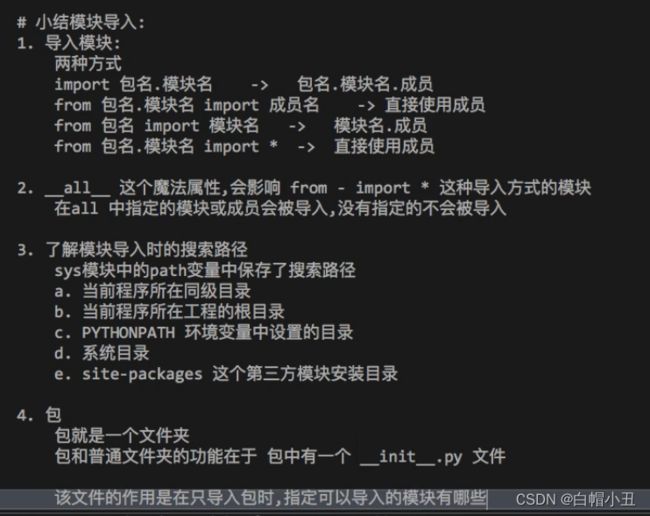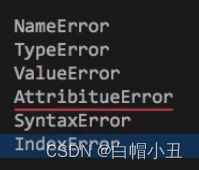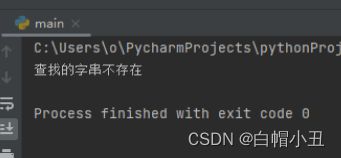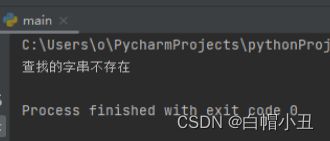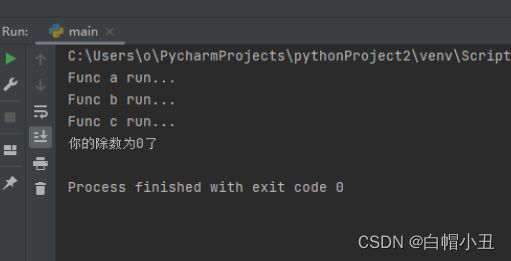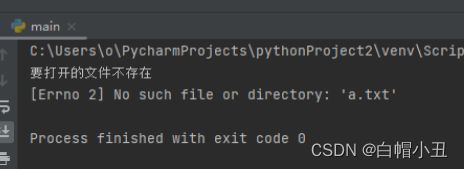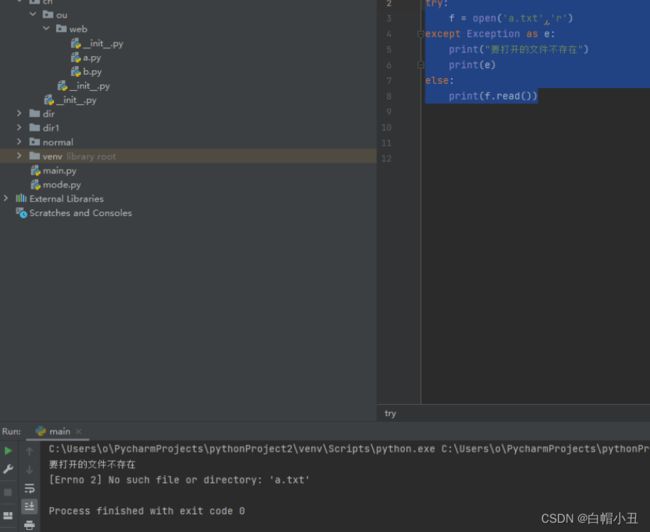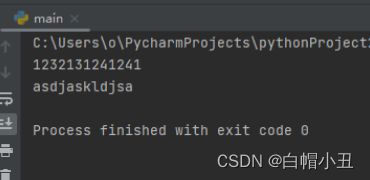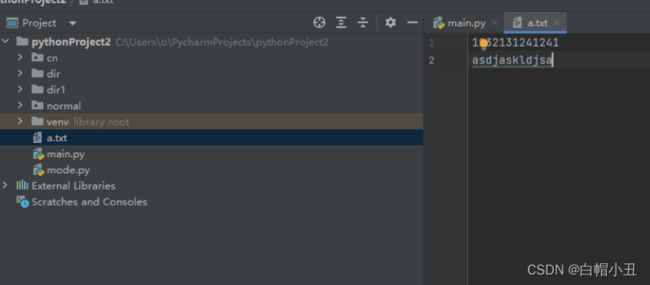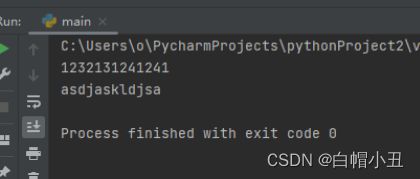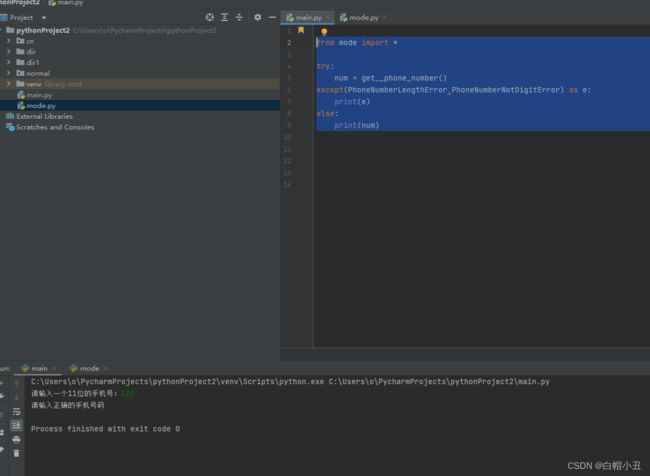python面向对象操作3(速通版)
目录
一、多态和类名
1.标准多态
2.实例属性和实例方法
3.类对象和类属性
4.对象保存
二、方法
1.类方法
3.四种方法的区别
三、模块
1.导入模块
2.自动模块导入
3.模块导入的几种形式
3.1模块导入的两种方式和别名
3.2 from 模块 import 成员
4.两种方法的区别和问题
7.包和模块
8.__init__和__all__属性的特性
9.小结
四、异常处理
1.基本异常处理
2.异常的传递
3.捕捉多个异常
4.else和finally
5.自定义异常抛出
结语
一、多态和类名
多种形态
程序中的意义:
当调用一个方法名的时候,得到的结果不同
在一般面向对象语言中,多态是由继承来实现的
但是在python中,python天生具有多态
1.标准多态
class Father(object):
def cure(self):
print("中医")
class Son(Father):
def cure(self):
print("中西医结合")
class Person(object):
#需要一个大夫治病
def need_docter(self,doctor):
doctor.cure()
p = Person()
p.need_docter(Father())
p.need_docter(Son())2.实例属性和实例方法
class Cat(object):
def __init__(self,name):
self.name = name
def info(self):
print(self.name)
def show(self):
print("show")
self.info()
tom = Cat('tom')
#使用实例属性
print(tom.name)
#实例方法
tom.info()
tom.show()实例方法
class Cat(object):
def __init__(self,name):
self.name = name
def info(self):
print(self.name)
def show(self):
print("show")
self.info()
tom = Cat('tom')
#使用实例属性
print(tom.name)
#实例方法
tom.info()
tom.show()
Cat.show(tom)
#类名不能调用对象属性
print(Cat.name)3.类对象和类属性
4.对象保存
class Cat(object):
def __init__(self,name):
self.name = name
self.__age = 1
def public_meth(self):
print("公有对象方法")
def __priv_meth(self):
print("私有对象方法")
tom = Cat('Tom')
jack = Cat('Jack')
print(Cat.__dict__)
print(tom.__dict__)
print(jack.__dict__)
tom.public_meth()
Cat.public_meth(tom)二、方法
1.类方法
定义格式:和写普通方法没什么区别,就是有个修饰
调用格式
应用场景
![]()
注意:类方法中不能使用self,但是可以使用其他对象填充cls,当前类对象,这个参数也是自动传递的
class MyMath(object):
#定义一个类属性
n = 999
@classmethod
#cls默认是这个类对象
def sum(cls,*args):
m = 0
for i in args:
m += i
return m
sum1 = MyMath.sum(1,2,3,4,5)
print(sum1)2.静态方法
格式:
@staticmethod
def 方法名(参数列表。。。):
pass
调用方式:
同类方法
类对象.静态方法名()
设计目的:
静态方法实际上就是放到类中的一堆普通函数
作用:
静态方法同类方法相似,也是在不需要实例对象产生的条件下,可以使用静态方法来实现
一般这两种方法,都是用在工具类的实现上
class EncodeUtil(object):
@staticmethod
def encode_data(data,format):
print(f'对数据{data} 使用 {format} 格式进行编码')
@staticmethod
def decode_data(data,format):
print(f'对数据{data} 使用 {format} 格式进行解码')
EncodeUtil.encode_data("hello",'utf-8')
EncodeUtil.decode_data("hello", 'GBK')3.四种方法的区别
# 实例方法,必须通过实例对象调用执行,(第一个参数是当前调用该方法的实例)
# 类方法:当不需要产生实例对象时,可以使用类方法来实现显影的代码功能,类方法可以直接使用类对象来调用,类方法的第一个参数时cls,用来接收当前类对象,通过各个参数,可以在各个类方法中进行共享数据
# 静态方法:作用同类方法相似,但是静态方法不接收任何默认参数(实例对象或类对象),静态方法其实就是将一些相关联的普通方法进行类的整合
类方法和静态方法大多数用来实现工具类
三、模块
在python中,一个py文件就是一个模块
模块也是对象
1.导入模块
import os
import time
import random
import sys
import functools
import os
import time
import sys
print(os.getcwd())
#阻塞函数
time.sleep(3)
print(sys.argv)2.自动模块导入
n = 1
def show():
print("mode show")
class Cat(object):
def show(self):
print("Cat_show")
print('mode ',n)
show()
c = Cat()
c.show()我们导入到main里面
#导入模块时,需要去创建该模块的对象,也就会去执行该模块文件中的所有代码
import mode
3.模块导入的几种形式
3.1模块导入的两种方式和别名
#导入模块时,需要去创建该模块的对象,也就会去执行该模块文件中的所有代码
import mode
#模块名调用
print("___________________")
print(mode)
mode.show()
print("____________________")
#类对象模块名调用
rom = mode.Cat()
rom.show()
print("____________________")
#别名
import mode as m
m.show()
m.Cat().show()3.2 from 模块 import 成员
from mode import n
print("____________________________________________")
print(n)
from mode import show
print("____________________________________________")
show()
#起别名
from mode import Cat as C
print("____________________________________________")
C().show()
#导出所有
from mode import *
print("____________________________________________")
Cat().show()
show()
print(n)4.两种方法的区别和问题
main导入
#import没有限制
import mode as m
print(m.x)
print(m._y)
print(m.__z)用from import导入
#import没有限制
from mode import *
print(x)
print(_y)
print(__z)可以通过__all__来解决这个问题
但是我们不提倡用这个方法
#改变规则来让私有属性能被引用
__all__ = ['x','_y','__z']
x = 1 #全局变量,模块间的公有变量
_y = 2 #私有变量,文件内私有变量
__z = 3 #私有变量,对象私有或类私有,不会直接在模块中定义
main
#import没有限制
from mode import *
print(x)
print(_y)
print(__z)
5.模块导入顺序
6.__name__属性
mode模块
n = 1
def show():
print('show')
class Cat(object):
def show(self):
print("Cat_show")
#当使用__name__属性在获取当前模块名时,会有两种效果
print('name: ',__name__)
main
import mode
#这里运行是代表人口
print('name2: ',__name__)
前面我们载入模块会自动执行一些调用的方法,我们可以用__name__来解决这个问题
n = 1
def show():
print('show')
class Cat(object):
def show(self):
print("Cat_show")
#当使用__name__属性在获取当前模块名时,会有两种效果
print('name: ',__name__)
if __name__ == '__main__':
print(n)
show()
Cat().show()
import mode
#这里运行是代表人口
print('name2: ',__name__)7.包和模块
导入包中的模块
调用
import normal.a
print(normal.a.m)
from import
from normal import a
print(a.m)8.__init__和__all__属性的特性
目录结构
cn.ou.web.*
当在使用import方式,或from-import方式导入包时,需要在__init__.py文件中,明确的指出可以被导入的模块有哪些。
使用from . import 模块名形式指定
如果在该文件中没有指定可以调入的模块时,默认不导入任何模块
from cn.ou import web
print(web.a.m)
print(web.b.c)
from cn.ou import web
print(web.a.m)
print(web.b.c)__all__导入方式
__all__ = ['a','b'] #导入a,b模块
#__all__ = ['a']
from import才可以导入__all__
from cn.ou.web import *
print(a.m)
print(b.c)9.小结
四、异常处理
1.基本异常处理
常见异常
这些错误都继承于Exception
index函数报错
s = "hello"
print(s.index('O'))
print('over')这个函数错误不会返回null,而是直接抛出一个异常,中断程序
那么我们捕获这个异常让他继续运行
s = "hello"
try:
print(s.index('O'))
except ValueError:
print("查找的字串不存在")
因为异常原因可能不知道,所以可以用Exception来接收这个异常,来抛出
s = "hello"
try:
print(s.index('O'))
except Exception:
print("查找的字串不存在")2.异常的传递
当代码出现了很多层级的调用时,在其中发生了异常,如果没有处理这个异常,那么这个异常会自动向上抛出,如果上层也没有处理,就会继续向上抛出,知道抛到解释器。
解释器默认处理异常的方式就是中断程序,将异常信息显示到工作台上
def func_a():
print("Func a run...")
func_b()
def func_b():
print("Func b run...")
func_c()
def func_c():
print("Func c run...")
print(1/0)
func_a()处理掉这个异常
def func_a():
print("Func a run...")
func_b()
def func_b():
print("Func b run...")
func_c()
def func_c():
print("Func c run...")
try:
print(1/0)
except Exception:
print('你的除数为0了')
func_a()3.捕捉多个异常
def func_a():
print("Func a run...")
func_b()
def func_b():
print("Func b run...")
func_c()
def func_c():
print("Func c run...")
try:
print(1/0)
except (ZeroDivisionError,NameError) as e:
print('出现异常了',e)
func_a()4.else和finally
打开文件问题
try:
f = open('a.txt','r')
except Exception as e:
print("要打开的文件不存在")
print(e)else
无文件报异常
try:
f = open('a.txt','r')
except Exception as e:
print("要打开的文件不存在")
print(e)
else:
print(f.read())有文件直接读取输出
try:
f = open('a.txt','r')
except Exception as e:
print("要打开的文件不存在")
print(e)
else:
print(f.read())
f.close()finally无论是否出现异常,都会执行finally语句块
try:
f = open('a.txt','r')
except Exception as e:
print("要打开的文件不存在")
print(e)
else:
print(f.read())
finally:
f.close()a.txt不存在时
这下又有异常了
这个问题处理
f = None
try:
f = open('a.txt','r')
except Exception as e:
print("要打开的文件不存在")
print(e)
else:
print(f.read())
finally:
if f != None:
f.close()5.自定义异常抛出
raise 异常对象
class PhoneNumberNotDigitError(Exception):
def __init__(self,msg):
self.__msg = msg
def __str__(self):
return self.__msg
class PhoneNumberLengthError(Exception):
def __init__(self,msg):
self.__msg = msg
def __str__(self):
return self.__msg
def get__phone_number():
pn = input("请输入一个11位的手机号:")
if pn.isdigit() == False:
raise PhoneNumberNotDigitError("请输入正确的手机号码")
elif len(pn) != 11:
raise PhoneNumberLengthError('手机号位数不正确')
print("输入的手机号是合法的: ",pn)
get__phone_number()输入a1234567890
输入正常格式的手机号
输入长度超过的数字
from import引用
class PhoneNumberNotDigitError(Exception):
def __init__(self,msg):
self.__msg = msg
def __str__(self):
return self.__msg
class PhoneNumberLengthError(Exception):
def __init__(self,msg):
self.__msg = msg
def __str__(self):
return self.__msg
def get__phone_number():
pn = input("请输入一个11位的手机号:")
if pn.isdigit() == False:
raise PhoneNumberNotDigitError("请输入正确的手机号码")
elif len(pn) != 11:
raise PhoneNumberLengthError('手机号位数不正确')
return pn
from mode import *
try:
num = get__phone_number()
except(PhoneNumberLengthError,PhoneNumberNotDigitError) as e:
print(e)
else:
print(num)
结语
双休了!光速更新!!!求点赞

